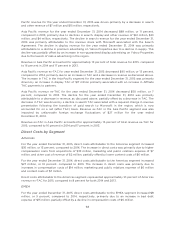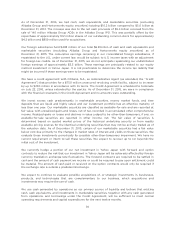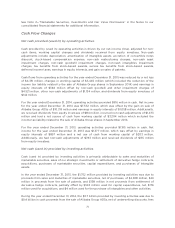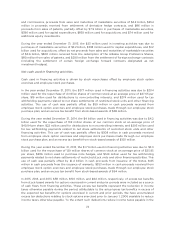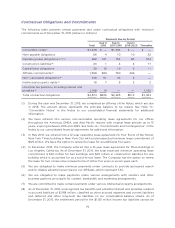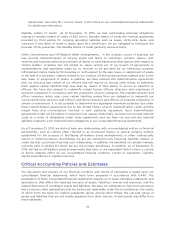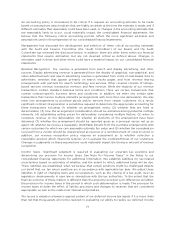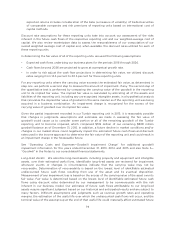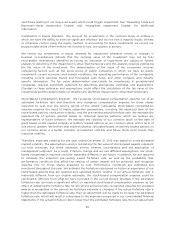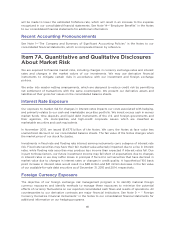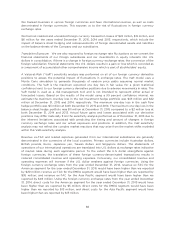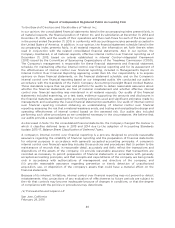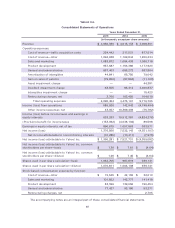Yahoo 2015 Annual Report Download - page 82
Download and view the complete annual report
Please find page 82 of the 2015 Yahoo annual report below. You can navigate through the pages in the report by either clicking on the pages listed below, or by using the keyword search tool below to find specific information within the annual report.tax assets we consider all available positive and negative evidence, including our operating results,
ongoing tax planning, and forecasts of future taxable income on a jurisdiction by jurisdiction basis. In
the event we were to determine that we would be able to realize these deferred income tax assets in
the future, we would make an adjustment to the valuation allowance, which would reduce the
provision for income taxes.
Goodwill. Goodwill is not amortized but is evaluated for impairment annually (as of October 31) or
whenever we identify certain triggering events or circumstances that would more likely than not
reduce the estimated fair value of a reporting unit below its carrying amount. Events or
circumstances that might indicate an interim evaluation is warranted include, among other things,
unexpected adverse business conditions, regulatory changes, loss of key personnel and reporting unit
and macro-economic factors.
Goodwill is tested for impairment at the reporting unit level, which is one level below our operating
segments. We identified U.S. & Canada, Latin America, and Tumblr as the reporting units below the
Americas operating segment; Europe and Middle East as the reporting units below the EMEA
operating segment; and Taiwan, Hong Kong, Australia & New Zealand, India & Southeast Asia as the
reporting units below the Asia Pacific operating segment. These operating segments are the same as
our reportable segments.
To test for impairment, we use the two-step quantitative test. The first step of the quantitative test
involves comparing the estimated fair value of our reporting units to their carrying values, including
goodwill. If the carrying value of the reporting unit exceeds its fair value, the second step of the
quantitative test is performed by comparing the carrying value of the goodwill in the reporting unit
to its implied fair value. An impairment charge is recognized for the excess of the carrying value of
goodwill over its implied fair value.
We use a combination of income and market approaches for valuing the reporting units. Refer to
Note 5—“Goodwill” in the Notes to our consolidated financial statements for discussion of the
methodologies utilized in 2015 and 2014 for each reporting unit. The components of these
approaches, as outlined below, require us to make assumptions about the timing and amount of
future cash flows, growth rates and discount rates. Significant management judgment is involved in
determining these estimates and assumptions, and actual results may differ from those used in
valuations. Changes in these estimates and assumptions could materially affect the determination of
fair value for each reporting unit which could trigger future impairment.
•Market comparables. We select comparable companies in the specific regions in which these
reporting units operate based on similarity of type of business, primarily those involved in online
advertising, relative size, financial profile, and other characteristics of those companies compared
to these reporting units. Forward revenue multiples derived from these comparable companies
are applied to financial metrics of these reporting units to determine their estimated fair values.
•Estimated future cash flows. We base cash flow projections for each reporting unit using a
forecast of cash flows and a terminal value based on the Perpetuity Growth Model. The forecast
and related assumptions were derived from the most recent annual financial forecast for which
the planning process commenced in our fourth quarter of 2015. Key assumptions in estimating
future cash flows include, among other items, revenue and operating expense growth rates,
terminal value growth rate, and capital expenditure and working capital levels.
•Discount rates. We employ a Weighted Average Cost of Capital approach to determine the
discount rates used in our cash flow projections. The determination of the discount rates for each
reporting unit includes factors such as the risk-free rate of return and the return an outside
investor would expect to earn based on the overall level of inherent risk. The determination of
78


